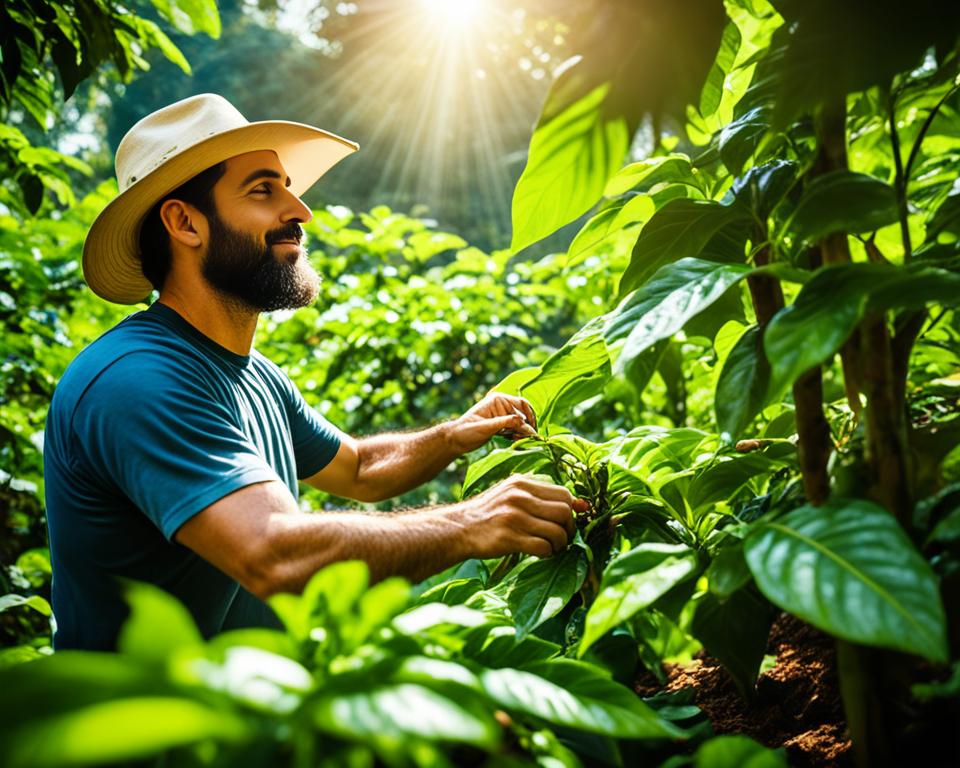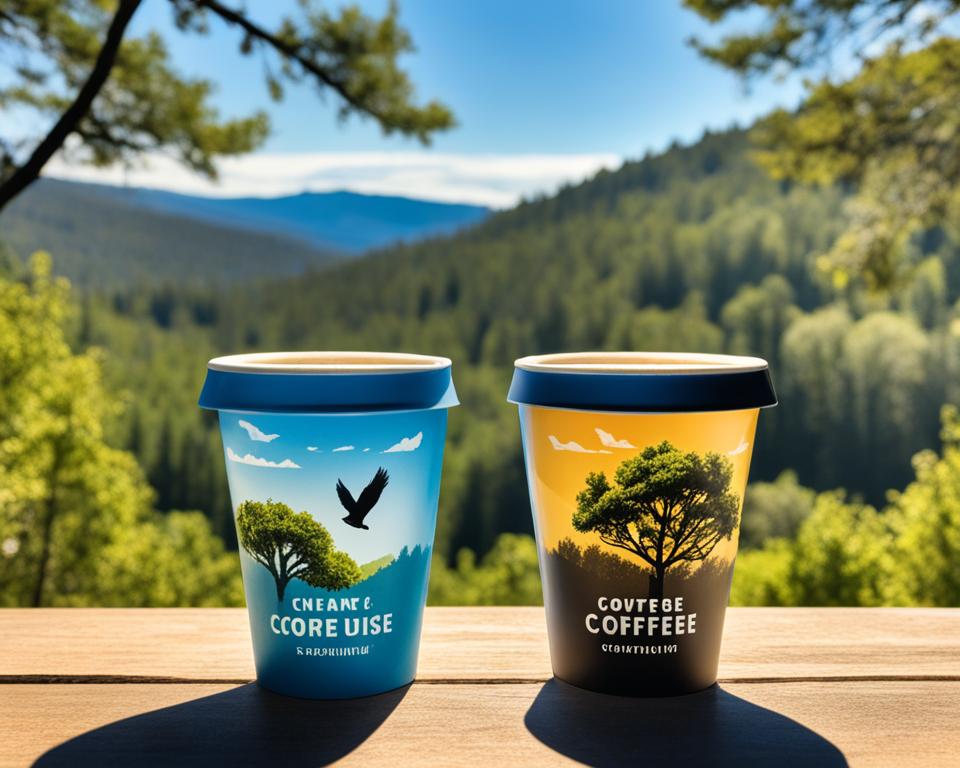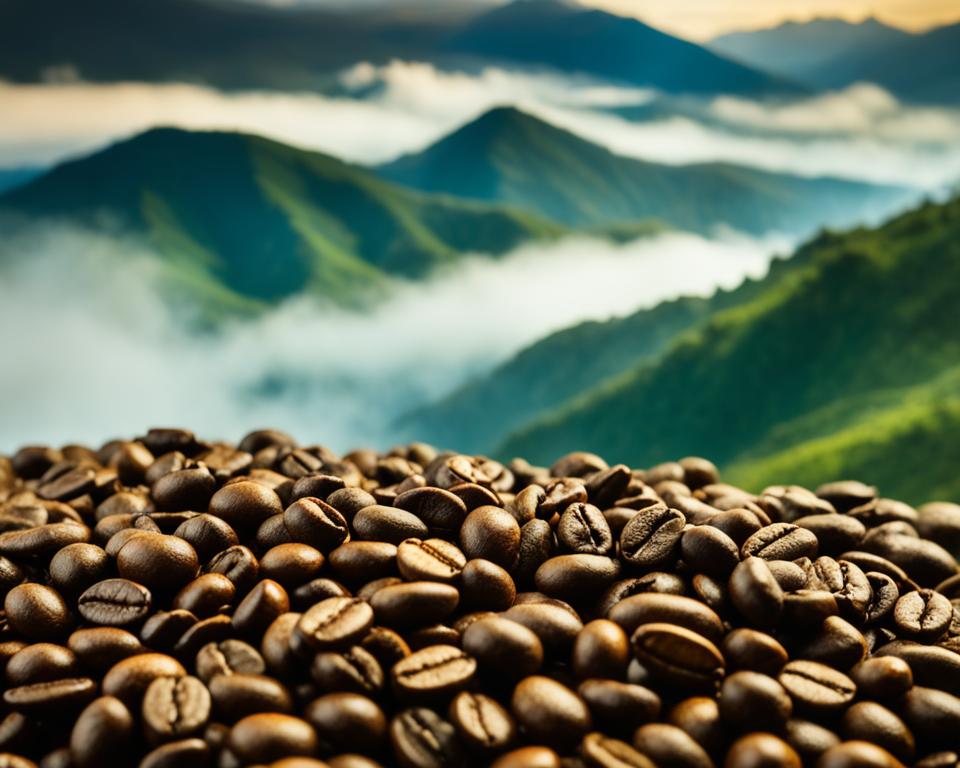Did you know that most of the coffee we drink comes from the sun? Yet studies show shade-grown coffee has better flavour and helps the environment more. This fact kicks off a journey into the tastes of shaded and sun-grown coffee and their impact on your coffee moments. In the coffee world, the tiny details and feelings of shade vs. sun-grown coffee are crucial.
Each sip shares a unique tale. Knowing the ways your coffee is grown adds depth to enjoying it. Whether it’s the complex tastes of shade-grown coffee or the shiny notes of sun-grown coffee, learning about their differences can enrich your coffee journey.
Let’s explore how the environment and growth conditions affect your coffee’s flavor. We’ll learn about the impact on nature and the detailed taste notes.
Understanding the gap between shaded and sun-grown coffee will boost your coffee wisdom. It might even help you find your next beloved brew.
Key Takeaways
- Understanding the nuances between shade-grown and sun-grown coffee can enhance your appreciation for your daily brew.
- Shade-grown coffee often offers richer, more complex flavours due to its unique growing conditions.
- Sun-grown coffee is typically brighter and more upfront in flavour.
- Environmental implications differ significantly between shade-grown and sun-grown coffee, with shade-grown being more sustainable.
- Diving deeper into these topics can lead to more informed choices and a greater connection to the coffee you drink.
The Basics of Shade and Sun-Grown Coffee
It’s key to know the difference between shade-grown and sun-grown coffee production practices, especially if you love coffee. Each method has its own way of growing, which affects taste and the planet.
Understanding Shade-Grown Coffee
Shade-grown coffee is grown under tree canopies. This method dates back a long time. It lets coffee plants grow how they would in the wild. That’s why it’s good for the earth, too.
Growing coffee in the shade needs fewer chemicals. The natural setup fights off pests and keeps the soil healthy.
Understanding Sun-Grown Coffee
On the other hand, sun-grown coffee grows in full sunlight. It’s more common on big farms. This has become popular to meet the world’s high coffee demands.
Plants are in the sun all the time. This makes them grow fast and be ready to pick more often. But it means using a lot of fertilisers and pesticides. This can be bad for the environment.
Flavor Profiles: What to Expect
Do you know what makes coffee taste different? The way coffee is grown affects its flavor. We will look at shade-grown and sun-grown coffee. And find out why their flavours vary.
Tasting Notes of Shade-Grown Coffee
Shade-grown coffee has rich, layered flavors. Imagine a cup with hints of fruit, chocolate, and flowers. Because these beans grow slowly under trees, they taste full-bodied but not too sour.
This slow growth also helps protect our environment.
Tasting Notes of Sun-Grown Coffee
Sun-grown coffee is quite different. It’s known for its bright, bold taste. This is because the sun makes the beans grow faster. So, these coffees might taste like citrus or even wine.
But this quick growth can harm the local nature.
How Growing Conditions Affect Flavour
Coffee’s flavour secrets lie in how it’s grown. Shade-grown beans love cool, steady climates under the trees. This makes them sweet and deep. On the flip side, sun-grown beans get a lot of heat and sun.
They ripen quickly, tasting more sharp and sour. Yet, this method challenges our environment.
| Aspect | Shade-grown coffee | Sun-Grown Coffee |
|---|---|---|
| Typical Flavors | Rich, Fruity, Chocolate, Floral | Bright, Citrus, Berries, and wine-like |
| Body | Full-bodied | Medium-bodied |
| Acidity | Well-balanced | Higher acidity |
| Growth Environment | Under canopy of trees | Direct sunlight |
| Environmental Impact | Supportive of biodiversity | More environmental challenges |
Benefits of Shade-Grown Coffee
Shade-grown coffee is a big deal for eco-friendly folks like me. It has advantages that help our planet, as does the coffee we drink every day.
Environmental Advantages
Shade-grown coffee has a smaller impact on our environment than sun-grown coffee. It doesn’t need deforestation and benefits from tree cover.
This cover helps keep the soil fertile, conserves water, and stops erosion. It also makes a cooler space for healthy coffee plants and top-notch beans.

Support for Biodiversity
Shade-grown coffee is a win for wildlife. By using native tree shade, it gives homes to many creatures. This is much better than the one-crop fields used for sun-grown coffee.
Places like the Smithsonian Migratory Bird Center say these farms help birds and other animals stay strong, protecting a wide variety of life.
Organic Shade Grown Coffee Options
If you like your coffee organic, there are lots of choices. Organic shade-grown coffees are grown without harmful chemicals. They are healthier for us and for farmers.
Look for certifications like USDA Organic and Fair Trade. They ensure the coffee is grown in an earth-friendly and ethical way. Brands like Equal Exchange and Birds & Beans are leaders in sustainable coffee.
They offer coffees that taste good and are good for the planet.
Sustainability and environmental impact
How we grow coffee impacts our world greatly. Coffee grown under trees, known as shade-grown coffee, is good for our planet. It keeps more plant and animal species around, stops dirt from washing away, and keeps rivers and streams clean.
On the other hand, the environmental impact of sun-grown coffee is a problem. To grow coffee in direct sunlight, trees are often cut down. This not only hurts where animals live but also adds lots of carbon to the air.
Choosing sustainable coffee farming practices is a better choice for our environment.
Certifications like the Rainforest Alliance help coffee farmers use methods that are better for the earth. When we buy coffee from these approved brands, we help the planet and support good farming.
| Aspect | Shade-grown coffee | Sun-Grown Coffee |
|---|---|---|
| Environmental Impact | Low | High |
| Ecosystem Health | Improves | Degrades |
| Biodiversity | Supports | Reduces |
| Carbon Footprint | Smaller | Larger |
Thinking about our choices can lead to a brighter future for coffee and our world.
Shade vs. Sun-Grown Coffee: Which Should You Choose?
Deciding between shaded and sun-grown coffee is a choice many face. It comes down to what you like and some key points. I’m here to help you figure out which one works for you.
Factors to consider
When you choose between shaded and sun-grown coffee, think about a few things:
- Flavour: Shade-grown coffee often has a deeper, more complex taste. But sun-grown coffees taste brighter and more vibrant.
- Environmental Impact: Shade-grown coffee helps more wildlife and uses less land. Sun-grown coffee can harm the environment by leading to deforestation.
- Price: Shade-grown coffee might cost a bit more. This is because it’s made with more care. But it’s often better for the planet and for the people growing it.
Popular Shade Grown Coffee Brands
If you’re interested in shade-grown coffee, know that there are great brands out there. These companies focus on both quality and how they grow their coffee.
- Allegro Coffee is well-known for its range of organic coffees.
- Equal Exchange: Leads in fair trade and organically grown coffee.
- Birds & Beans specialises in shade-grown coffee that’s friendly for birds and the earth.
Tips for Buying Quality Coffee
Want to buy good coffee, whether it’s shaded or sun-grown? Here are some tips:
- Check Certifications: Look for USDA Organic, Fair Trade, or Rainforest Alliance labels. These show the coffee was made in ways that are good for people and the planet.
- Understand the Roast Date: Aim to buy coffee that’s been recently roasted. It tastes best this way.
- Know your preferences: Decide if you like light, medium, or dark roasts. This can help you pick the perfect coffee for you.
How Does the Processing Method Affect the Taste of Shade vs. Sun Grown Coffee?
The processing method significantly impacts the taste of shade vs. sun grown coffee. While shade grown coffee benefits from a slower maturation, enhancing sweetness and complexity, sun grown varieties often carry more vibrant acidity. To truly understand these nuances, coffee enthusiasts should explore the flavors of wet and dry coffee.
Conclusion
Exploring shade versus sun-grown coffee shows how different growing methods change your coffee. Shade-grown coffee has bold flavours and helps the environment. In contrast, sun-grown coffee tastes lighter but can harm nature.
Shade-grown coffee supports many types of life and helps the planet stay cooler. It’s a favourite for those who care about the Earth. Yet, sun-grown coffee focuses on producing a lot, which can be bad for the environment.
Your choice depends on what matters most to you. If deep flavour and helping the planet are key, choose shade-grown coffee. But if you like the bright flavours of sun-grown coffee, go for that. Each type has its own good points, so it’s cool to try both. See what meets your taste and values best.
FAQ
What is the difference between shade-grown and sun-grown coffee?
Shade-grown coffee grows under tree canopies. It makes for a complex ecosystem and richer flavors. Sun-grown coffee, on the other hand, grows in direct sunlight. This leads to quicker growth and more production. Sadly, it can cause deforestation and the loss of diverse plants and animals.
What are the benefits of shade-grown coffee?
Shade-grown coffee has advantages for the earth. It supports a wide range of plants and animals while creating tasty beans. It’s also often farmed organically.
How do the growing conditions affect the flavour of shaded versus sun-grown coffee?
Shade-grown coffee tastes more complex and deep. This is because the beans take longer to mature in the shade. Sun-grown coffee, in contrast, has a bold flavor. Its fast growth and sunlight exposure quicken its flavour development.
Are there any notable environmental impacts of sun-grown coffee?
Sun-grown coffee can harm the environment greatly. It is linked to deforestation, soil erosion, and less biodiversity. It often uses chemicals that can damage the area around it.
What are some of the best shade-grown coffee brands?
Top-shaded-grown coffee includes Counter Culture Coffee and Equal Exchange. Bird-friendly coffees from the Smithsonian Migratory Bird Center are also praised. These brands focus on both quality and helping the planet.
What makes shade-grown coffee more sustainable than sun-grown coffee?
Shade-grown coffee is better for the earth. It saves important tree cover and promotes healthy ecosystems. It’s often farmed without harmful chemicals.
How can I identify organic, shade-grown coffee?
Check for labels like USDA Organic and Fair Trade. These show the coffee was grown in a way that’s good for the environment.
What factors should I consider when choosing between shaded and sun-grown coffee?
Think about what flavours you like, your impact on the environment, and your budget. Shade-grown coffee offers deep flavours and is better for the planet. However, sun-grown coffee is easier to find and less expensive.
How can I support sustainable coffee farming practices?
Choose coffee with labels like Rainforest Alliance and Fair Trade. These ensure the coffee was grown in ways that are good for both people and the planet.
What are some tips for buying quality coffee?
For the best coffee, look for fresh-by dates, where the coffee comes from, and ethical certifications. Over all, go for whole beans. Grinding them at home keeps the taste and aroma fresh.




